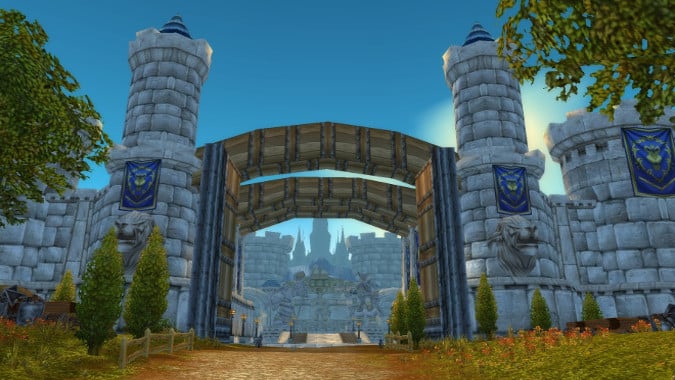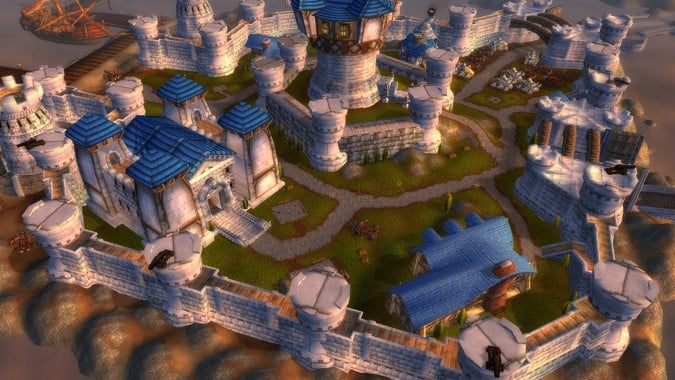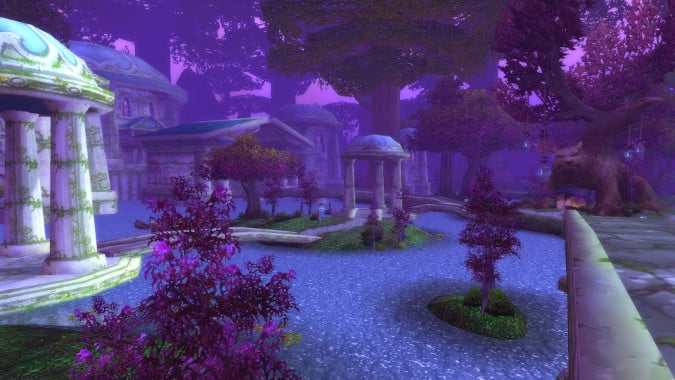Know Your Lore: The Alliance at the beginning of World of Warcraft

This Know Your Lore is a little bit different. I thought it might be interesting to look at where the Horde and Alliance were at the start of World of Warcraft — where things began, how events have shaken out, and how the two factions were sizing one another up in the post-Third War world. The map of the world had changed. After millennia, the Eastern Kingdoms and Kalimdor were once again aware of each other, and expeditions had been sent to Northrend as well. The Night Elves of Kalimdor had joined the Alliance, no longer a collection of human nations, but now a pact between Humans, Night Elves, Dwarves, and Gnomes.
Meanwhile, the Forsaken under Sylvanas had negotiated with Warchief Thrall of the Horde and brought their nation of undead under the aegis of the Horde itself, which now boasted Trolls and Tauren in addition to Orcs. The events of Reign of Chaos and The Frozen Throne had come and gone — Durotar had been founded, Admiral Daelin Proudmoore was dead, and Illidan Stormrage had failed in his attempt to destroy The Lich King, who had joined with Arthas Menethil atop the spire at Icecrown Glacier. And no one knew what to expect from him, either.

A new Alliance
When World of Warcraft debuted, we were presented with a world where the fragile but hopeful truce between Orcs and Humans (along with Night Elves and Tauren and Trolls) forged atop Mount Hyjal to defeat the Burning Legion had not lasted. The actions of Daelin Proudmoore and his Kul Tiras forces — sailing into Theramore and raiding the Orcish settlement of Durotar — were one reason for the collapse of the truce. While Jaina assisted the Horde against her own father in hopes of preserving peace, anti-human sentiments among the Orcs of Durotar won out in the end.
This was exacerbated by Sylvanas’s move to bring the Forsaken into the Horde. While the logic of Thrall’s move was sound — like the Orcs themselves, the Forsaken were seen as monsters by the Alliance races, outcasts in need of a mutually beneficent arrangement — they were also sitting in the middle of the largest former Human kingdom, and many of the refugees who’d fled Lordaeron for Stormwind wanted to go home. The idea that they’d never return home because moldering corpses were squatting there didn’t sit well with them.

Theramore and Stormwind
With the destruction of Lordaeron, the sealing away of Gilneas (not to be opened for another several years), and the disappearance of Kul Tiras, there were two centers of human power on Azeroth. One was Theramore, the island settlement created off the shore of Kalimdor by Jaina Proudmoore. This fortress outpost was imposing but fairly small, and primarily settled by a few shiploads of refugees from Lordaeron and environs. Theramore contained a disproportionately high amount of veterans of the Scourge attack on Lordaeron and the Battle for Mount Hyjal, but it was small and ruled by a woman who sought peace with the Horde. This led, ultimately, to it being eclipsed by Stormwind.
Unlike Theramore, Stormwind had escaped the Third War completely unscathed. In fact, none of the southern Eastern Kingdoms (Dun Morogh, Stormwind, and so on) had been touched by the Legion or the Scourge. While the influx of refugees was a drain on Stormwind’s resources, the nation would have been in a prime position to become the dominant force in human affairs if not for the sudden disappearance of its King, Varian Wrynn, on a peace mission. Wrynn would not return to his throne for years, leaving his son Anduin as Stormwind’s ruler, with Bolvar Fordragon as his regent until he came of age, and Katrana Prestor as a somewhat sinister-seeming power behind the throne.
As for the mage-city of Dalaran, destroyed by Archimonde during the opening of the invasion, the remains of the former city sat behind an impenetrable magical barrier, and none who were not members of the Kirin Tor were allowed entry. No one, not even the nearby Forsaken, could say what the magical city was up to, or if it was indeed up to anything at all, at that time. Humanity could not look to magic for its salvation in the world that followed the Third War.

Gnomeregan falls, Ironforge endures
The Gnomes had suffered a calamity of their own while the Legion was invading Azeroth: A trogg invasion and treachery from within had led them to a forced exodus from their beloved Gnomeregan and into exile within Ironforge, the city of their Dwarven neighbors. Ironforge remained intact, a bastion of power under King Magni Bronzebeard. Only the most seasoned observers realized Magni’s house was in disorder, as his daughter Moira would vanish into the depths of Blackrock Mountain, seemingly kidnapped by the Dark Iron Dwarves and their Emperor Thaurissan.

The Children of the Stars
Humans, Gnomes, and Dwarves found common cause with the Night Elves of northern Kalimdor, a proud and fierce society who’d endured ten thousand years as the remnants of the people who first battled the Burning Legion during the War of the Ancients. Reduced in scope (for Night Elf ruins can be found all across Azeroth, from the shaded forest of Darkshire to the Hinterlands of Aerie Peak, and down into Feralas) but nevertheless an aggressive people, the actions of the Horde during the Third War (specifically their destruction of the Night Elves’ forests and slaying of Cenarius) had left a wedge that Human diplomats were able to exploit. While the Night Elves had first greeted Humans with violence due to their inherent xenophobia, they ultimately chose to join the Alliance. But all was not well in Night Elf society, for while Tyrande Whisperwind endured as High Priestess of Elune and leader of her people, Malfurion Stormrage had not remained awake following the destruction of the World Tree and the revocation of his people’s immortality. While he slept fitfully, it was one of his former students, Archdruid Fandral Staghelm, who was not quiet about his desire to supplant Tyrande as leader of their people.
This was the state of the Alliance four years after the Third War. Humanity was divided between a strong but pacifistic leader of a small nation and a larger, potentially powerful Kingdom (perhaps the strongest single nation in the known world of Azeroth at that time) which lacked the strong leadership it needed. The Gnomes were without a home, the Dwarves hid their divisions, and the Night Elves displayed theirs openly.
The Horde appeared at first glace to be far more united. The key word there is appeared. There were deep divisions that would become clear with time. Next week we’ll look at how the Horde had changed since the Third War and the founding of Durotar.
Please consider supporting our Patreon!
Join the Discussion
Blizzard Watch is a safe space for all readers. By leaving comments on this site you agree to follow our commenting and community guidelines.
 @MatthewWRossi
@MatthewWRossi




